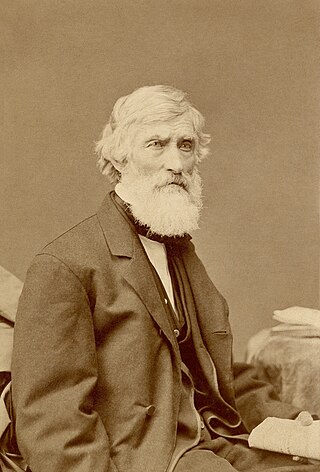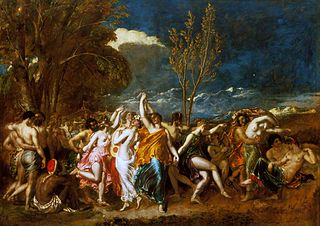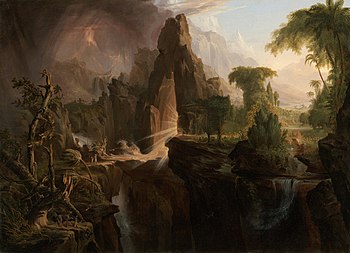Painting
The title of the painting, Expulsion from the Garden of Eden, refers to the story of Adam and Eve's expulsion from Eden in the Book of Genesis, which is the founding narrative for Christian explanations of sin and evil.
Traditionally, representations of the event usually have Adam and Eve as the focal point, with their despair at their expulsion conveyed through their figures. However, as an artist of the Hudson River School, Cole emphasized the landscape rather than the figures. [1] Dwarfed by the landscape, Adam and Eve have minimal detail. While their posture and expression indicate their disgrace in conventional terms (they cover their faces, and Eve as the more guilty party leads the way), Cole seeks to convey their despair primarily through the landscape.
Consistent with a more or less dualistic vision of good and evil espoused by many strains of Christianity, the composition is divided exactly in half. On the viewer's right is Paradise, from which Adam and Eve are forcibly thrust by a bright ray of light, which likely symbolizes God. Paradise emanates radiance and is a source of light and joy in the universe. It is vibrant, full of life with lush wildlife, and blue skies. [2]
On the left side of the picture, the outside world is portrayed as the opposite of Paradise. It is dark and ominous, as hinted in the decaying trees, volcano in the background, and the wolf devouring a deer in the bottom left corner, as a vulture flies by, hoping to scavenge some of the carcass.
Provenance
Upon its completion in 1828, Expulsion from the Garden of Eden was first exhibited to the public later that year with his Garden of Eden (Amon Carter Museum). [3] They were exhibited together at the National Academy Museum and School, which was then known as the National Academy of Design in New York. Cole was a founding member of the National Academy and exhibited his works there in the hopes of selling them or garnering commissions.
In 1829, Expulsion from the Garden of Eden was bought by the prominent doctor David Hosack, who is known as the doctor that tended to Alexander Hamilton after his fatal duel. In addition to medicine, Hosack was a patron of the arts. He was a member of the American Academy of the Fine Arts and promoted the works of Samuel Morse and Cole through purchasing their works for his own personal collection. Upon Hosack's death in 1835, Expulsion from the Garden of Eden was left to his third wife, Magdalena Coster. When Coster died in 1846, John Kearney Rodgers, the husband of Hosack's youngest daughter, Emily Hosack, inherited the painting. [4]
Eventually, in 1849, the painting was bought by James Lenox, a famed collector of paintings and books. [5] Lenox exhibited the painting in the art gallery of his Lenox Library. Although he died in 1890, the painting remained on display in the Lenox Library, as listed in the 1892 gallery guide. [6] However, the Lenox Library was facing financial difficulties, so in 1895, the painting along with other art of the Lenox Library was consolidated with the Astor Library and Tilden Trust to form the collection of the newly created New York Public Library (NYPL). [7] In 1943, the NYPL sold the painting to raise money. It was auctioned at Parke-Bernet Galleries on April 16, 1943. The painting was bought by Arnold Seligmann, Rey, & Co., a New York art dealership. [8]
Maxim Karolik, an art collector, acquired the painting later that year. His wife, Martha Catherine Codman Karolik, donated the painting to the Museum of Fine Arts in Boston. The MFA officially acquired the painting on June 12, 1947. [9] It has been in their collection ever since and can be seen on display in their galleries. [10]

The Hudson River School was a mid-19th-century American art movement embodied by a group of landscape painters whose aesthetic vision was influenced by Romanticism. Early on, the paintings typically depicted the Hudson River Valley and the surrounding area, including the Catskill, Adirondack, and White Mountains.

Thomas Cole was an English-born American artist and the founder of the Hudson River School art movement. Cole is widely regarded as the first significant American landscape painter. He was known for his romantic landscape and history paintings. Influenced by European painters, but with a strong American sensibility, he was prolific throughout his career and worked primarily with oil on canvas. His paintings are typically allegoric and often depict small figures or structures set against moody and evocative natural landscapes. They are usually escapist, framing the New World as a natural eden contrasting with the smog-filled cityscapes of Industrial Revolution-era Britain, in which he grew up. His works, often seen as conservative, criticize the contemporary trends of industrialism, urbanism, and westward expansion.

Asher Brown Durand was an American painter of the Hudson River School.

John Martin was an English painter, engraver, and illustrator. He was celebrated for his typically vast and dramatic paintings of religious subjects and fantastic compositions, populated with minute figures placed in imposing landscapes. Martin's paintings, and the prints made from them, enjoyed great success with the general public, with Thomas Lawrence referring to him as "the most popular painter of his day". He was also lambasted by John Ruskin and other critics.

The Amon Carter Museum of American Art is located in Fort Worth, Texas, in the city's cultural district. The museum's permanent collection features paintings, photography, sculpture, and works on paper by leading artists working in the United States and its North American territories in the nineteenth and twentieth centuries. The greatest concentration of works falls into the period from the 1820s through the 1940s. Photographs, prints, and other works on paper produced up to the present day are also an area of strength in the museum's holdings.

Giovanni di Paolo di Grazia was an Italian painter, working primarily in Siena, becoming a prolific painter and illustrator of manuscripts, including Dante's texts. He was one of the most important painters of the 15th century Sienese School. His early works show the influence of earlier Sienese masters, but his later style was more individual, characterized by cold, harsh colours and elongated forms. His style also took on the influence of International Gothic artists such as Gentile da Fabriano. Many of his works have an unusual dreamlike atmosphere, such as the surrealistic Miracle of St. Nicholas of Tolentino painted about 1455 and now housed in the Philadelphia Museum of Art, while his last works, particularly Last Judgment, Heaven, and Hell from about 1465 and Assumption painted in 1475, both at Pinacoteca Nazionale (Siena), are grotesque treatments of their lofty subjects. Giovanni's reputation declined after his death but was revived in the 20th century.

Robert Seldon Duncanson was a 19th-century American landscapist of European and African ancestry. Inspired by famous American landscape artists like Thomas Cole, Duncanson created renowned landscape paintings and is considered a second generation Hudson River School artist. Duncanson spent the majority of his career in Cincinnati, Ohio and helped develop the Ohio River Valley landscape tradition. As a free black man in antebellum America, Duncanson engaged the abolitionist community in America and England to support and promote his work. Duncanson is considered the first African-American artist to be internationally known. He operated in the cultural circles of Cincinnati, Detroit, Montreal, and London. The primary art historical debate centered on Duncanson concerns the role that contemporary racial issues played in his work. Some art historians, like Joseph D. Ketner, believe that Duncanson used racial metaphors in his artwork, while others, like Margaret Rose Vendryes, discourage viewers from approaching his art with a racialized perspective.

The Utah Museum of Fine Arts (UMFA) is a state and university art museum located in downtown Salt Lake City on the University of Utah campus. Housed in the Marcia and John Price Museum Building near Rice-Eccles Stadium, the museum holds a permanent collection of nearly 20,000 art objects. Works of art are displayed on a rotating basis.
Maxim Karolik, born in what is now Ukraine, he became a featured tenor for the Imperial Russian Grand Opera. He toured in Europe as a young man. He left Russia during the Bolshevik Revolution and moved to the United States to continue study of music.

Benvenuto di Giovanni, also known as Benvenuto di Giovanni di Meo del Guasta was an Italian painter and artist known for his choral miniatures, pavement designs, and frescoes. Working chiefly in Siena, he was first recognized to be working as an artist in 1453 and continued his work nearly until his death in approximately 1518. During his lifetime, he was influenced by various artists and in the 1480s, Benvenuto's style changed drastically.

Adam and Eve is the title of two famous works in different media by Albrecht Dürer, a German artist of the Northern Renaissance: an engraving made in 1504, and a pair of oil-on-panel paintings completed in 1507. The 1504 engraving depicts Adam and Eve in the Garden of Eden, surrounded by several symbolic animals. The engraving transformed how Adam and Eve were popularly depicted in art.

The Lenox Library was a library incorporated and endowed in 1870. It was both an architectural and intellectual landmark in Gilded Age–era New York City. It was founded by bibliophile and philanthropist James Lenox, and located on Fifth Avenue between 70th and 71st Streets on the Upper East Side of Manhattan. Renowned architect Richard Morris Hunt designed the building, which was considered one of the city's most notable buildings until its destruction in 1912.

Hans Olaf Halvor Heyerdahl was a Norwegian Realist painter. His work was characterized by naturalism and focused largely on portraits and landscape paintings.

The World Before the Flood is an oil-on-canvas painting by the English artist William Etty, first exhibited in 1828 and currently in the Southampton City Art Gallery. It depicts a scene from John Milton's Paradise Lost in which, among a series of visions of the future shown to Adam, he sees the world immediately before the Great Flood. The painting illustrates the stages of courtship as described by Milton: a group of men select wives from a group of dancing women, drag their chosen woman from the group, and settle down to married life. Behind the courting group, an oncoming storm looms, foreshadowing the destruction which the dancers and lovers are about to bring upon themselves.

Valley of the Yosemite is a painting by the German American painter Albert Bierstadt that was completed in 1864. Initially associated with the Hudson River School, Bierstadt rose to prominence for his paintings of the Rocky Mountains, which established him as one of the best painters of the western American landscape. His later paintings of Yosemite were also received with critical acclaim and public praise.

Dismissal of School on an October Afternoon was painted by Henry Inman. An elected founding member of the National Academy of Design, Inman was well known in the New York City art scene. Although predominately known for his portrait paintings, Henry Inman was also known for painting genre scenes and literary subjects. Commissioned by James Cozzens, this painting was finished on November 8, 1845, which makes it his last completed painting before his January 1846 death. It is a culmination of his successful career, as it is a blend of landscape, genre, and literary reference.
Elise Constance Mourant was a New Zealand artist. Works by Mourant are held in the collection of the Museum of New Zealand Te Papa Tongarewa.

Martha Catherine Codman Karolik was a philanthropist and American art collector based in Newport, Rhode Island. In 1939 and 1947 she and her husband Maxim Karolik donated two major collections of early American furniture, paintings, and prints and drawings to the Boston Fine Arts Museum, which built a new wing to house it. While the couple had purchased many of the nineteenth-century paintings and other works of their 1947 donation, much of the first collection donated in 1939 consisted of works she had inherited, which were collected by family and colonial ancestors.
The Expulsion from the Garden of Eden and the Expulsion from Paradise refer to the Biblical account of the ejection of Adam and Eve from the Garden of Eden as part of the Fall of man.
















